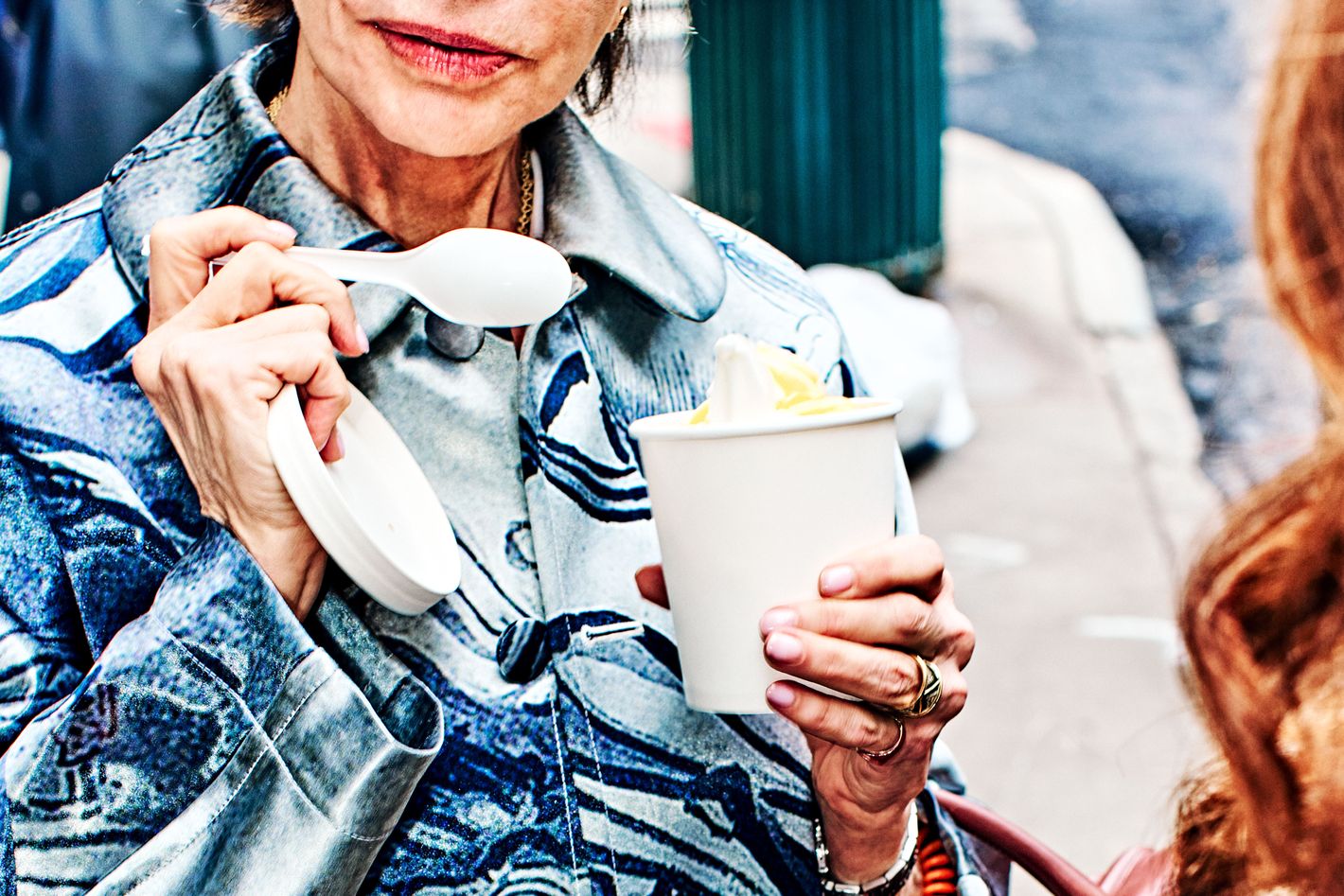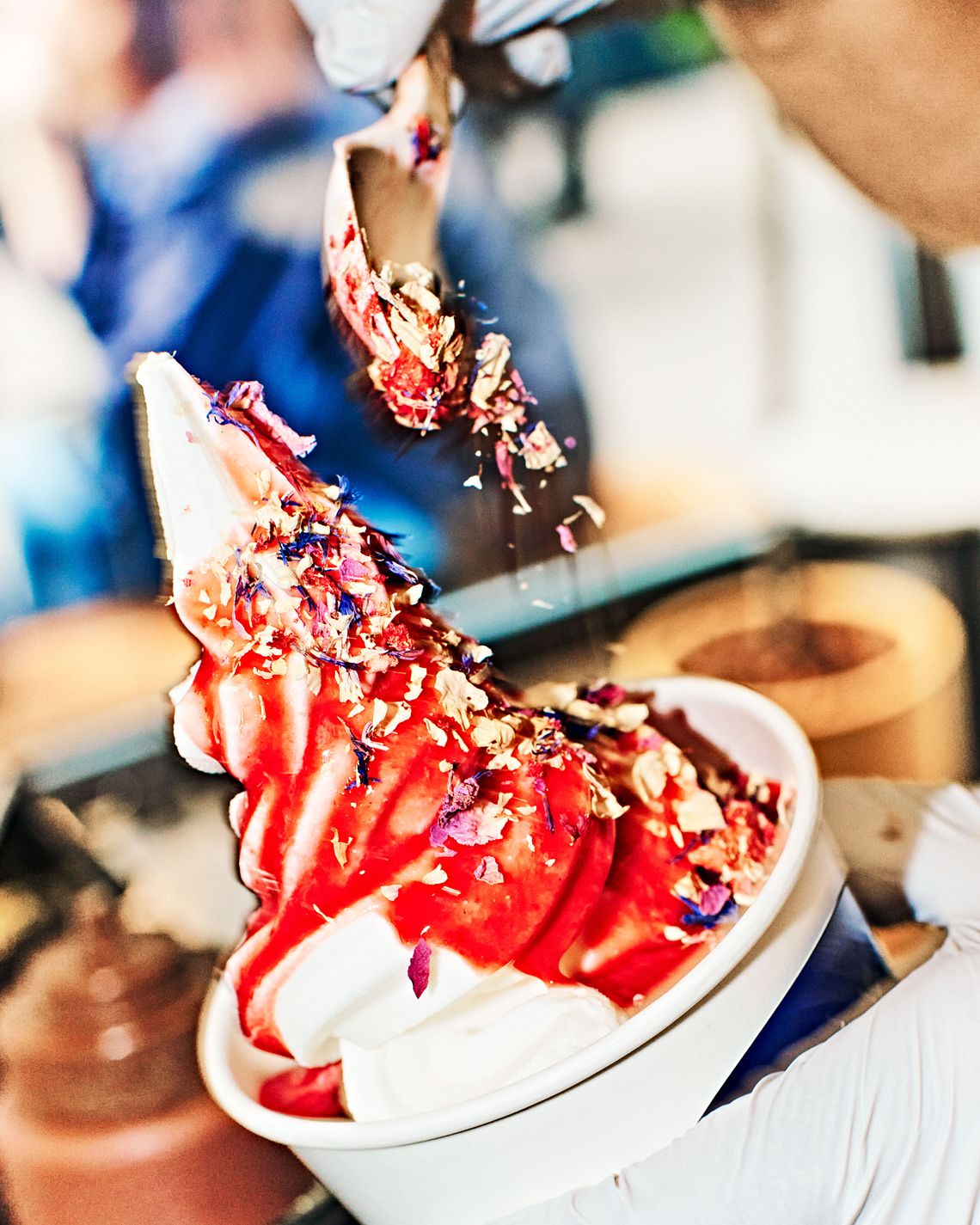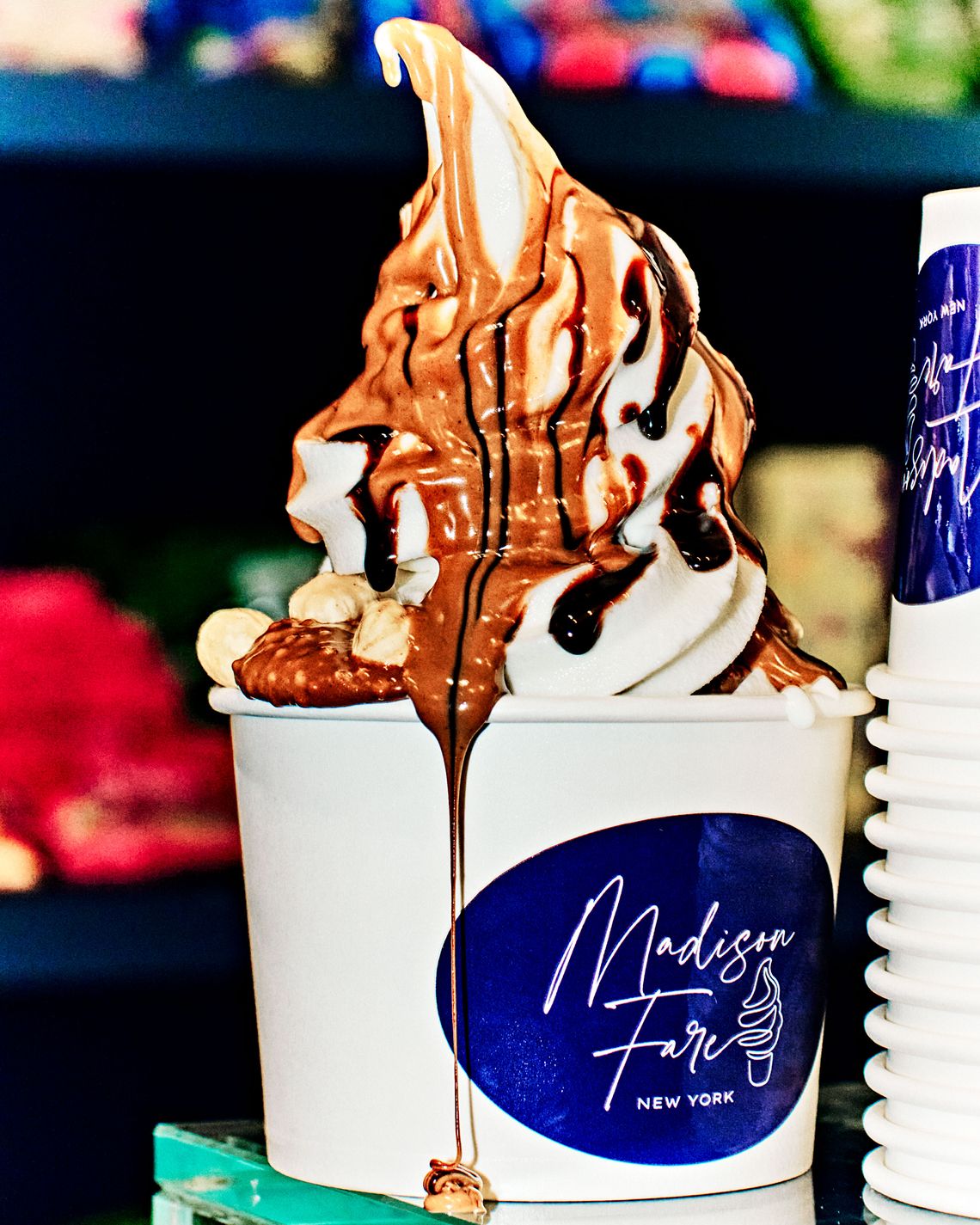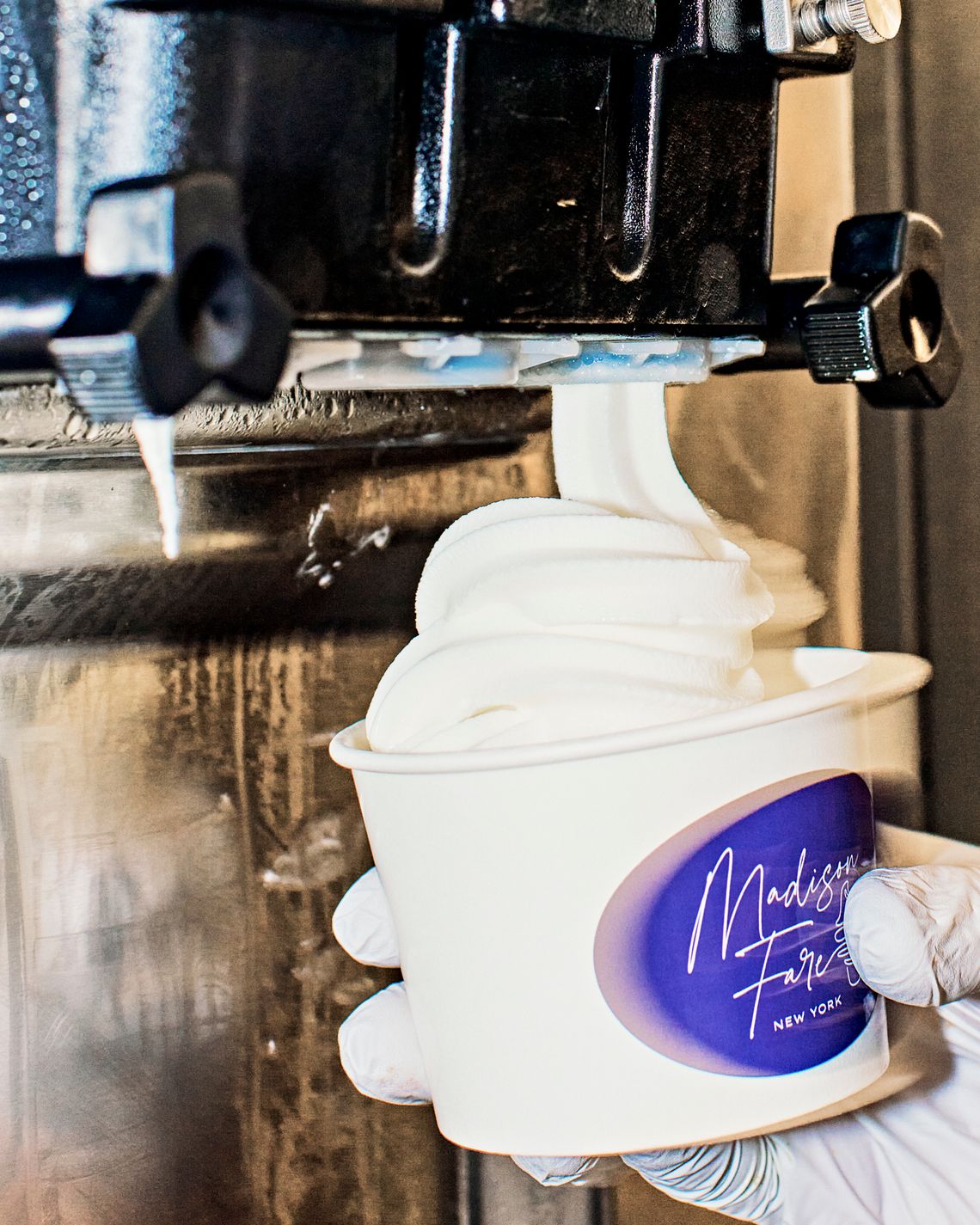when you want, where you want.
This City Is Ready for Some Fro-Yo
 Photo: Heami Lee/B)HeamiLee
Photo: Heami Lee/B)HeamiLee
Every day on the Upper East Side, lines snake outside the neighborhood’s two Butterfield Markets. These crowds are particularly striking because of the diversity of age on display: There are old people. There are babies. There are couples, nannies, tourists, friends, and medical professionals. At 3 p.m. on a recent Wednesday, a pair of crop-topped grad students transplanted from California stood ahead of a taut, impatient middle-aged Australian in athleisure. “We don’t need the queue to be any longer than it is!” she interjected, nudging everyone along. Everyone, no matter the age, waits for the same thing: Butterfield Market’s house frozen yogurt, swirled into robin’s-egg-blue cups and, inevitably, posted to Instagram. “I think it’s pretty worth the hype,” said the more yogurt savvy of the Californians.
She preferred it to the fro-yo from Madison Fare, three blocks uptown, where earlier that day a quintet of contoured Chicagoans had been eating frozen Greek yogurt bathed in Dubai-chocolate–inspired pistachio sauce. “We just saw it on TikTok!” said a 22-year-old named Amy. Fro-yo had been on their vacation itinerary: Central Park, Broadway, Madison Fare. Frozen yogurt, generally, was “definitely getting popular again,” she added, driven by a combination of nostalgia and the fact that “access to social media creates a way for people to market their random businesses and stuff.”
Influencers and would-be influencers alike are perpetually posting about one yogurt or the other: This fro-yo is 10/10, so worth it, it is oh my God the best yogurt they have ever had. Madison Fare added its yogurt last summer. Chef Amin Kinana had wanted to drum up business when his regulars fled the city for the Hamptons. The response was immediate and overwhelming: “I didn’t get it, to be honest. I was like, Okay, whatever, this is gonna die out soon, but it didn’t. It just keeps going and going,” he said. “This thing with yogurt is growing very big.”
It would be possible to write this off as an Upper East Side phenomenon, a tiny Frozen Yogurt Triangle, except this is a city that’s prone to fro-yo booms, and in talking to dozens of fans over the past few weeks, it has become clear that something bigger really is happening in regard to this thing with yogurt.
 Photo: Heami Lee
Photo: Heami Lee
I tried to get in touch with someone from Pinkberry, onetime icon of the big-city fro-yo scene, to ask whether it planned to capitalize on the fro-yo frenzy, but nobody at its corporate headquarters in Arizona called me back (notably, its parent company, Kahala Brands, also runs the last two Tasti D-Lites in New York). Instead, I walked over to the Pinkberry store in Park Slope to talk to an employee. She has been with the company for 11 years. Nothing much has changed, she told me (“except the prices!”). It was still busy, especially right after school. I asked her what the most popular flavor was these days, and she told me all of them.
Pinkberry may be resting on its laurels, but one of its longtime competitors is not. 16 Handles is the spiritual opposite of the artisanal Madison Fare or the Erewhon-like Butterfield, yet it, too, is making a play to recapture the attention of this city and many other cities as well. Neil Hershman, the chain’s 30-year-old CEO, took over in 2022, with YouTube star Danny Duncan — whose merch line includes “Virginity Rocks” T-shirts and “MILF Patrol” hoodies — as chief creative officer. Together, they launched what they intend to be a frozen-yogurt renaissance. Hershman, who has a vested interest in saying so, is emphatic that we as a culture are on the precipice of a new yogurt moment. “Our brand has just been on a tear these last few years, up and up and up,” he said, citing “three straight years of over 10 percent revenue growth.” A lot of that is in suburban areas — 16 Handles is opening new stores in Texas, South Carolina, Florida, and Arizona — but Hershman has his eye on Brooklyn (“A growth market for us right now”); “the forgotten borough, Staten Island” (his words); and, of course, Manhattan, although he “can’t disclose exactly where and when.”
If Hershman means downtown, he will be competing with Culture, which has been open for a decade but is where “every West Village Girl” is currently on line, according to Mélisse Martineau, who is 25 and works in fashion. “We’ll text and be like, ‘Culture?’ You can get out of the house, go for a little walk, meet up,” she said. “You don’t have to spend $20 and get drunk. It’s just very wholesome.”
Butterfield Market is also expanding fro-yo’s reach beyond uptown: This summer, a location is opening in Long Island City with — for the first time — self-serve fro-yo. “That’s kind of big news,” said Joelle Obsatz, a third-generation owner (along with her brother) and the head of marketing. “I don’t know how Instagrammable it’ll be compared to our served fro-yo, but I think people will be happy.” She added, ”There’s some nostalgia to fro-yo.”
Nostalgia for what? Unlike ice cream, which evokes childhood, fro-yo evokes eras, often one that spans from 2006 (the opening of Manhattan’s first Pinkberry, on West 32nd Street) to roughly 2014, a stretch of years defined by Girls, Fleet Foxes, The Book of Mormon, and diced strawberries or sugary cereal spooned atop tart swirls of low-fat green-tea yogurt. Fro-yo shops had “colonized the entire island of Manhattan and claimed large chunks of the boroughs,” lamented The Observer in 2012, listing them: “Yogurtland, Yogurt Station, Yorganic, Crazy Bananas, Off the Wall, Yogurt Culture, Strawberry Fields, Yogorino, Victory Garden, Forty Carrots, Village Yogurt, Phileo Yogurt, Berrywild, Lorax Frozen Yogurt, The Lite Choice, Chill Berry, Yogurt City, YoGo Yogurt Truck, and Yogo Swirl,” and that wasn’t even counting the “indefatigable national chains.”
“We won’t be surprised when we see a sickening 7-Eleven slithering into this spot, or a frozen-yogurt banality,” Jeremiah Moss wrote in Jeremiah’s Vanishing New York, mourning the 2013 closure of the Rawhide, a historic leather bar in Chelsea. For years, frozen yogurt was special, and then it was a blight, and then everyone moved on to green juice.
 Photo: Heami Lee
Photo: Heami Lee
One fro-yo evangelist waiting for the resurgence is Maya Kosoff, who is 32 and moved to New York in 2014. At the time, Red Mangos and Pinkberries were all over the city, but their numbers soon dwindled. Four years ago, Kosoff started texting the group chat: What had happened to them all? “We were like, ‘On a hot summer day sometimes, what would really do the trick is a small bowl of original tart frozen yogurt with some strawberries and mochi topping.’” Everyone on the group chat agreed that is exactly what they wanted, but where could they find it? “There were basically no fro-yo places left,” Kosoff said. “I think it’s nostalgia for, like, a moment in time in the 2010s. I don’t know why people are nostalgic for that. I don’t even know why I’m nostalgic for it.” I wondered if what she might be nostalgic for was not yogurt but youth.
Nearly everyone I spoke to, regardless of their NYC arrival date, told me that frozen yogurt is nostalgic, including Connor Nix, a regional director for Bloomingdale’s, which is home to Forty Carrots, a yogurt pioneer. Bloomingdale’s credits itself for introducing New York to what was in the early ’70s called “frogurt” and has been extruding it, steadily, elegantly, ever since. People (mostly women) had been taken by their parents (mostly mothers) or their grandparents, and now, Nix tells me, they are “bringing the next generation” — mostly daughters — “to it.” The fro-yo wave of the mid-aughts was itself a throwback to the craze of the ’80s and early ’90s, when frozen yogurt emerged as a low-fat, low-calorie alternative to ice cream. “Eating ice cream has a stigma now, like smoking,” a New Jersey woman named Alison Weiss told the New York Times in 1991. “If someone comes into the store while I’m waiting for my frozen yogurt and asks for ice cream, I stare at them. There’s a whole guilt thing about ice cream.” Frozen yogurt, however, exuded an “aura of health,” she said, even though, as the article explained, frozen yogurt isn’t actually healthy by most standard metrics, and the calories per ounce are never quite as low as one might want.
“It’s not a salad, it’s still dessert. It’s still got milk fat and cream, it’s still got sugar in it,” conceded Hershman, the 16 Handles CEO. “But what if you could have less of all those things?”
This is the timeless appeal of yogurt. It is indulgence without punishment, goodness without suffering. “I think my love of frozen yogurt came from a desire to have something abundant and that can be all mine in this world but that won’t hurt me,” said the author and poet Melissa Broder. I had called her because frozen yogurt factors heavily in her second novel, Milk Fed, where it both suppresses and awakens appetites, which suggests she understands the promise of fro-yo in a spiritual sense. “Frozen yogurt,” she continued, “is one of the closest things we get to heaven.” I was never quite able to unlock what everyone was really looking for when they lined up for some frozen yogurt, but Broder probably got closest to finding it: “It’s this longing for the infinite and the eternal, but without consequence — sort of like the desire for God.”
 Photo: Heami Lee
Photo: Heami Lee All Rights Reserved. Copyright , Central Coast Communications, Inc.